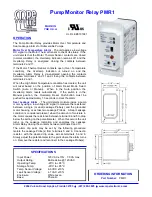
Anschluß
• Versorgungsspannung an Klemmen A1
(+) und A2 (-) anschließen.
• Meßkreis
- Einphasenmotor: Die Phase des Motors
an L1, den Nulleiter an L3 anschließen.
Klemmen L1-L2 brücken.
- Dreiphasenmotor: Die drei Phasen des
Motors an die Klemmen L1, L2 und L3
anschließen.
• Rückführkreis
- Öffnerkontakte der zu überwachenden
Schütze am Rückführkreis Y1-Y2 an-
schließen oder - wenn nicht benötigt -
Brücke Y1-Y2 einlegen.
• Halbleiterausgang für Schaltzustand:
Die Klemme Y31 an das 24-V-Potential
der SPS, Klemme Y30 an 0 V und
Klemme Y32 an einen SPS-Eingang
anschließen.
• Halbleiterausgang für Störmeldung:
Die Klemme Y31 an das 24-V-Potential
der SPS, Klemme Y30 an 0 V und
Klemme Y35 an einen SPS-Eingang
anschließen.
• Halbleitereingang für Reset:
Die Klemme RESET an einen SPS-
Ausgang anschließen.
Einstellung und Ablauf
• Bei Motorstillstand Potentiometer nach
rechts drehen, dann Potentiometer nach
links drehen, bis die LEDs "Channel 1"und
"Channel 2" leuchten.
Die LED "Output" leuchtet noch nicht.
Die Sicherheitskontakte 13-14 und 23-24
sind geöffnet, der Hilfskontakt 41-42 ist
geschlossen, der Halbleiterausgang
Y31-Y32 ist hochohmig.
• Rückführkreis schließen, Motor anlaufen
lassen und wieder abschalten. Sobald
der Motor steht, leuchten die LEDs
"Channel 1", "Channel 2" und "Output"
und die Ausgangsrelais schalten. Die
Sicherheitskontakte 13-14 und 23-24 sind
geschlossen, der Hilfskontakt 41-42 ist
geöffnet, der Halbleiterausgang Y31-Y32
ist leitend.
Wieder aktivieren
• Der Rückführkreis muß geschlossen sein.
• Die Spannungen an den Meßkreisen
müssen gleichzeitig den Ansprechwert
(Stillstandsschwelle) unterschreiten.
• Leuchten die LEDs "Channel 1" und
"Channel 2" während des Gleichzeitig-
zeitraumes nicht gleichzeitig, dann ist
die Störmeldung an Klemme Y35 aktiv
und die LED "FAULT" leuchtet.
Das Gerät kann
- durch kurzes Unterbrechen der
Versorgungsspannung
- oder durch Anlegen und wieder
wegnehmen von 24 V DC an den
RESET-Eingang aktiviert werden.
Überprüfung - Fehlerursachen
Mit dem Selbsttest nach Einschalten der
Versorgungsspannung kann überprüft
werden, ob das Gerät ordnungsgemäß
auslöst bzw. sich wieder aktivieren läßt.
Das Gerät kann aus Sicherheitsgründen bei
folgenden Fehlern nicht gestartet werden:
• Fehlfunktion der Kontakte:
Bei verschweißten Kontakten ist nach
Öffnen des Eingangskreises keine neue
Aktivierung möglich
• Leitungsunterbrechung in Kanal 1 oder
Kanal 2
• Rückführkreis offen
Connection
• Connect the operating voltage between
A1
i
(+) and A2 (-).
• Measuring circuit
- single-phase motor: connect the Live to
L1 and the neutral conductor to L3. L1-
L2 must be linked.
- three-phase motor: connect the three
windings to L1, L2 and L3
• Feedback Control Loop
Connect the n/o contact of the relay to be
monitored to the feedback control loop
Y1-Y2 or - if not needed - bridge Y1-Y2.
• Semiconductor output:
Connect the terminal Y31 to the 24 V
Potential of the PLC, terminal Y30 to 0 V
and terminal Y32 to a PLC input.
• Semiconductor output for fault signalling:
Connect terminal Y31 to the PLC 24 V
supply, terminal Y30 to 0 V and terminal
Y35 to a PLC input.
• Semiconductor input for reset:
Connect the RESET terminal to a PLC
output.
To set and operate
• When the motor is at standstill turn
potentiometer to the right and then to the
left until the LEDs "Channel 1" and
"Channel 2" are illuminated. The LED
"Output" is not illuminated. The safety
contacts 13-14 and 23-24 are open, the
auxiliary contact 41-42 is closed and the
semiconductor output Y31-Y32 is non-
conducting.
• Close feedback control loop, run motor
and then switch off. When the motor
reaches the standstill threshold, the LEDs
"Channel 1", "channel 2" and "Output" are
illuminated and the output relays switch.
The safety contacts 13-14 and 23-24 are
closed, the auxiliary contact 41-42 is open
and the semiconductor output Y31-Y32
conducts.
Reactivation
• The feedback control loop must be closed.
• The voltages on the measuring circuits
must fall below the response value.
(standstill thresholds) simultaneously.
• If the "Channel 1" and "Channel 2" LEDs
do not light up simultaneously during the
simultaneity period then the
fault signal at terminal Y35 is active and
the LED "FAULT" lights up.
The device can be activated
- by briefly interrupting the supply voltage
- or by connecting and then removing 24
V DC to the RESET input.
Testing - Fault causes
After applying operating voltage, a self-test
is carried out to check that the unit functions
correctly.
For safety reasons, the unit cannot be
activated if the following faults are present:
• Faulty contact functions:
In the case of welded contacts, no further
activation is possible following an opening
of the input circuit.
• Cable break in channel 1 and channel 2
• Feedback control loop open
Branchement
• Raccorder la tension d'alimentation aux
bornes A1 (+) et A2 (-)
• Circuit mesure :
- Commande en 1 canal (moteur mono-
phasé): ramener la phase du moteur
sur L1, le neutre sur L3 et ponter les
bornes L1-L2.
- Commande en 2 canaux (moteur
triphasé) : ramener les trois phases du
moteur sur L1, L2 et L3
• Boucle de retour :
Câbler les contacts à ouverture des
contacteurs à surveiller dans la boucle de
retour Y1-Y2 ou - quand ce n'est pas
nécessaire - relier les bornes Y1-Y2.
• Sortie statique:
Ramener le 24 V à la borne Y31, le 0 V à
Y30 et relier la borne Y32 à une entrée
API.
• Sortie statique pour signal de défaut :
Raccorder la borne Y31 au potentiel 24 V
de l'API, la borne Y30 au potentiel 0 V et
la borne Y35 à l'entrée de l'API.
• Entrée statique pour Reset :
Raccorder la borne RESET à une sortie
de l'API.
Mise en oeuvre
• Le moteur étant à l'arrêt, tourner le
potentiomètre vers la droite, puis vers
la gauche jusqu'à ce que les LEDs
«Channel 1» et «Channel 2» s'allument.
La LED «Output» est encore èteinte. Les
contacts de sécurité 13-14 et 23-24 sont
ouverts, le contact d'info 41-42 est fermé,
la sortie statique Y31-Y32 est bloquée.
• Fermer la boucle de retour, mettre en
route le moteur puis le stopper. Dès que le
moteur est arrêté, les LEDs «Channel 1»,
«Channel 2» et «Output» s'allument et les
contacts de sécurité 13-14 et 23-24 se
ferment. Le contact d'info 41-42 est ouvert
et la sortie statique Y31-Y32 est passante.
Réarmement
• La boucle de retour est fermée.
• Les tensions mesurées sur les canaux
d'entrée doivent passer en dessous des
valeurs affichées dans l'intervalle de
temps autorisé (désynchronisme).
• Si les LEDs «Channel 1» et «Channel 2»
ne s'allument pas simultanément pendant
la période de synchronisme, le signal de
défaut à la borne Y35 est actif et la LED
«FAULT» s'allume.
L'appareil peut être activé
- en interrompant quelques instants la
tension d'alimentation
- ou en appliquant quelques instants une
tension de 24 V DC à l'entrée RESET.
Vérification - Sources d'erreur
L'autotest interne à la mise sous tension
permet de vérifier le bon déclenchement de
l'appareil et sa remise en marche.
Pour garantir la fonction de sécurité, le relais
n'est pas réarmé en si les défauts suivants se
produisent ::
• Défaut de fonctionnement des contacts de
sortie : cas de soudage d'un contact lors
de l'ouverture du circuit d'entrée, un
nouveau réarmement est impossible.
• Rupture de liaison sur les canaux 1 et 2.
• Boucle de retour ouverte.






























